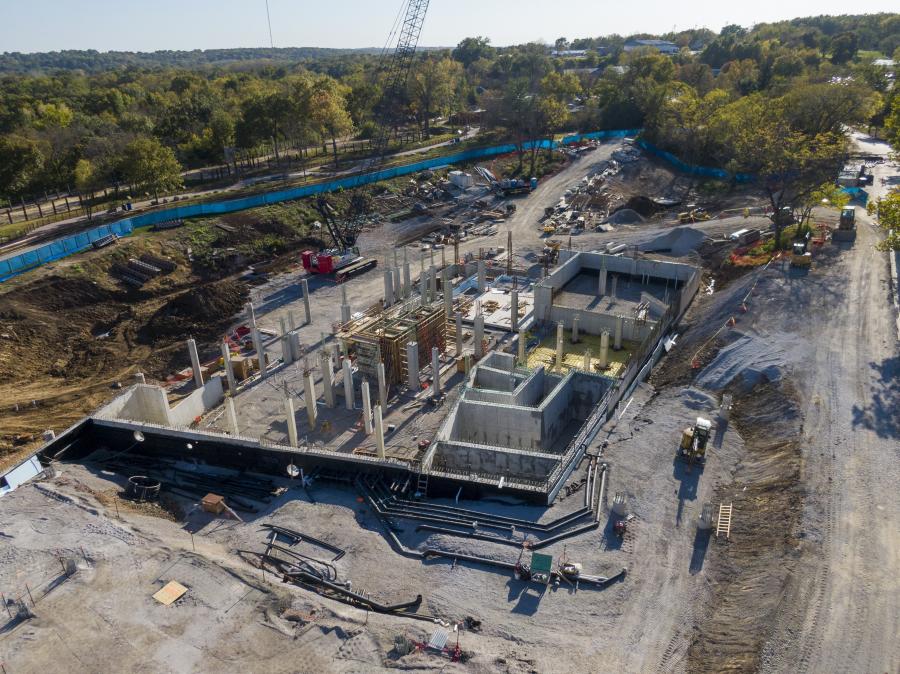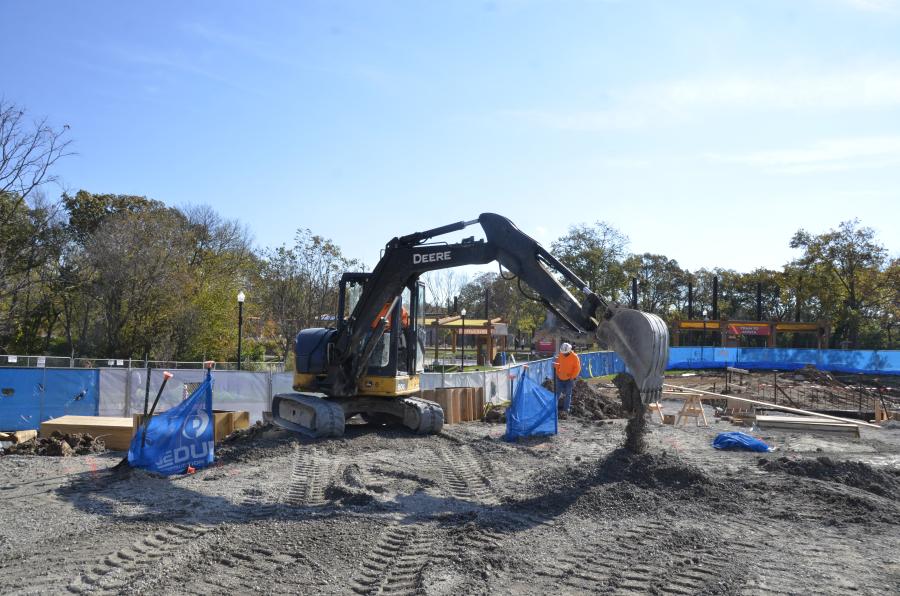Kansas City Zoo’s new $75 million 600,000-gal. aquarium has JE Dunn Construction crews working through winter conditions.
(Kansas City Zoo photo)
As the single largest undertaking in the Kansas City Zoo's 112-year history, a new, 600,000-gal. aquarium has crews working through a winter conditions plan to keep construction going through Missouri's coldest months. The $75 million project required years of research and planning before actual work could begin.
"The aquarium is something that we have been discussing for a long time, so to finally see it come to fruition is truly exciting for everyone," said Randy Wisthoff, Kansas City Zoo executive director and CEO. "We cannot wait to bring the ocean to Kansas City. We want to make sure that every child in Kansas City can experience the ocean, and realize the importance of conserving it, even here in the middle of the country. The Kansas City Zoo aquarium will make you feel like you've traveled to the bottom of the ocean and back again, as you move through its six zones containing about 30 exhibits."
The structure is situated near Helzberg Penguin Plaza, within easy distance of the front gate.
"From the moment you step in the door to see and hear waves hitting the shore, you begin your descent to see sharks and other creatures at their darkest depths, then you'll come back out on the opposite shore where sea otters play," said Wisthoff. "The aquarium will be home to thousands of marine animals from around the globe, including sharks, octopus, sea turtles and rescued sea otters."
Roughly one million people visit the zoo each year, but an outside feasibility study estimated that the aquarium could increase attendance by about 300,000 annually. Funding for the project is being provided by the Zoological District of Jackson and Clay Counties in Missouri, as well as through private donations.
Wisthoff said the ongoing fundraising campaign is going well.
"The biggest need was for another indoor space that our zoo guests can visit year-round," said Wisthoff.
The public space will be on one level, but there are multiple levels that include the life support systems that the aquarium's staff will need to access. The space will be approximately 70,000 sq. ft.
Wisthoff noted that contractor JE Dunn was the perfect fit for the highly anticipated project.
"They won the bid by competing against several other qualified construction companies. Over the years, JE Dunn has completed several projects at the zoo, and has been an outstanding partner. We know this company's history, and have been very pleased in the past with their ability to stay on time and budget. We feel confident because we know we are putting every effort into making the aquarium a world-class destination in their hometown.
"We're continuously working closely with the contractor to limit the impact that the construction has on our regular zoo guests. There have been times where guest rerouting has been necessary, but the contractor understands that visitor satisfaction is of great importance to us. They have helped us limit these diversions so our guests can just focus on their zoo experience."
Robert Lee, JE Dunn project manager, described the project as complex, with many challenges.
"Some of those include ensuring that the concrete exhibit tanks are watertight, as well as the coordination of all the underground and overhead life support systems. And doing the work in an active zoo adds its own layer of complexity, especially where safety is concerned."
Early site work began in February 2021 to complete the necessary demolition and early site utilities prior to the zoo's busy summer months. Workers were fully mobilized for pier and footing and foundation work in June 2021.
"We just wrapped up basement-level basin and foundation work, and current work with under-slab MEP and Life Support System [LSS] installation is ongoing. Next, we'll be working on the basement-level slab-on-grade to allow us to continue with exhibit-level elevated tank mat slabs and elevated pedestrian slabs."
Constructing the aquarium requires footings and foundations; underground MEP and LSS; foundation and basin walls; elevated exhibit mat slab and pedestrian pathway elevated slabs; as well as the setting of large-scale acrylic panels; tank waterproofing; overhead MEP and LSS piping; structural steel; exterior skin; artificial rockwork and coral; large MEP and LSS equipment setting; interior finishes; commissioning of MEP and LSS equipment systems; and the acclimation of animals.
With the zoo's existing infrastructure surrounding the site, JE Dunn will utilize existing hydrants for the initial fill of all the tanks. Final fill will be completed through the aquarium's life support system to allow for biological cycling of the filters.
Lee added that each of the six exhibit zones will be unique.
"All tanks will require some sort of life support system for filtration of the water. There are different types of tanks, such as concrete tanks with large scale acrylic viewing panels, acrylic cylinders and FRP tanks with acrylic viewing windows. Some tanks will receive artificial rockwork and coral to imitate oceanic habitats."
Before work began, the site served as the bear grotto, but had not been used for many years. Crews tore out the existing exhibits, some of which were constructed in the 1940s, along with some old walkways, but much of the space was an unused, wooded area.
In addition to concerns related to the wet curing of concrete, workers have been dealing with COVID-19 and the supply chain impacts that have come with it, including specialized equipment and materials coming from overseas. They've also had to confront a significant amount of solid limestone/rock removal required for below-grade MEP, LSS and site utility installation. A total of 22,656 cu. yds. of import materials was required to bring the site up to final grade.
Lee said 120 drilled piers are complete, as well as footing and foundation work, underground MEP and LSS pipe, duct and raceways.
Equipment required on the job includes modular cranes/hoists; generators; switchgear; specialty light fixtures for tanks; air handling units; heat exchangers; dedicated outdoor air units; water-cooled chillers; cooling towers; life support systems; controls for the LSS; filters; sand; glass; gravel; process type and submersible pumps and motors; micro-bead bioreactors; fractionators; reverse osmosis system; sand filter; valves; and ultraviolet sterilizers.
Main materials include 5,220 cu. yds. of concrete; 1,050 tons of rebar; 187 tons of steel; under slab HDPE (3,800 linear ft.); and more than 5 mi. of overhead PVC/CPVC (26,600 linear ft.).
A total of 18 large-scale acrylic panels — the heaviest being nearly 30,000 lbs. — also will be needed, along with four acrylic cylinder tanks; 18 FRP exhibit tanks; metal wall panel; wood soffit; stucco; curtain wall exterior finish; large-scale acrylic panels; fiberglass tanks with acrylic viewing windows; rockwork structures for tanks; and epoxy tank waterproofing membrane.
Lee pointed out that building an aquarium has many differences from more traditional projects, the biggest being the weight of the water.
"Because of this, the overall structure [concrete and reinforcing] is beefed up, and any reinforcing that interacts with a wet wall or slab is epoxy-coated. There also are special requirements to meet for concrete wet curing to minimize shrinkage in tank slab and vertical concrete walls."
The most time-consuming part of the construction involves the concrete structure, with the wet curing requirements through the winter months, along with tank waterproofing and artificial rockwork, because it is sequence driven.
According to Susan Schaefer, JE Dunn project executive, the contractor has a national reputation for delivering excellence on large, complex and unique projects.
"In addition, we've developed a strong relationship with the Kansas City Zoo and understand the inner workings of the site and how to work with the zoo to achieve their goals. Being a long-term partner for the Kansas City Zoo has been rewarding for JE Dunn for many decades. Our aquarium team has served the zoo for recent projects that include the penguin exhibit and elephant exhibit. Being a part of these exciting projects that impact the community is indeed rewarding.
"Now, having the opportunity to be a part of their largest project ever is nothing short of an honor. We get to help create a world-class aquarium in the Midwest that is unique, impactful, inclusive and meaningful, and connects people to each other and to the natural world to promote understanding, appreciation and conservation. This exhibit will no doubt serve as a source of pride for Kansas City and the Kansas City Zoo." CEG
Today's top stories




















